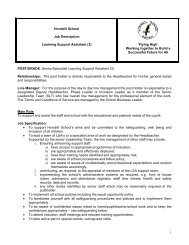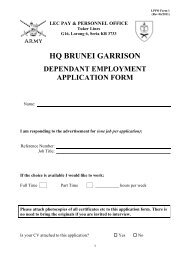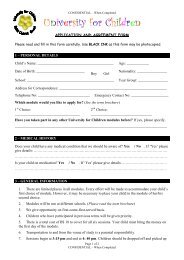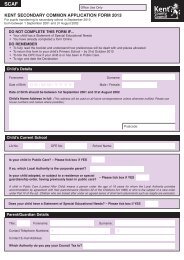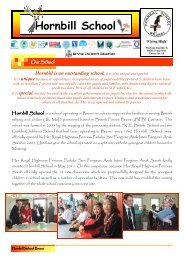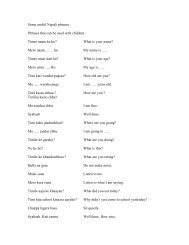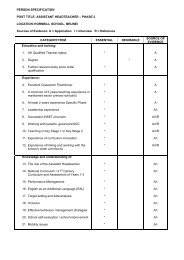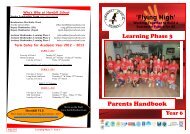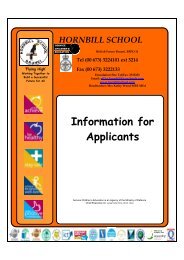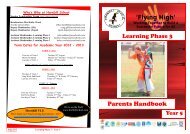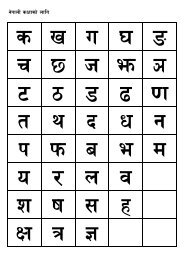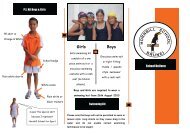2009-2010 - Hornbill School Website
2009-2010 - Hornbill School Website
2009-2010 - Hornbill School Website
Create successful ePaper yourself
Turn your PDF publications into a flip-book with our unique Google optimized e-Paper software.
29<br />
of the child will be continuously monitored and recorded and reviewed at the<br />
end of term.<br />
• The children requiring support will be identified as being at Early Stages of<br />
Acquiring Language A Group (ESAL A) if they require intensive language support<br />
or Early Stages of Acquiring Language B Group (ESAL B) if they require only<br />
some language support.<br />
•<br />
Termly<br />
• At the end of each term, the NST and class teacher will review the progress of<br />
the child using the Individual Review Sheet.<br />
• Evidence e.g. photocopies of work, reading records, progress charts should be<br />
gathered to support whether a child has met his/her targets in part or full or<br />
not met the targets at all.<br />
• The NST teacher should keep the original copy of this sheet and evidence in a<br />
class or cohort EAL folder. A copy of this should be given to the Deputy<br />
Headteacher (Nepal) who will then present the information to the Senior<br />
Leadership Team for further discussion and suggestions.<br />
Guidelines for EAL Assessments<br />
1. Nepali children who arrive in <strong>Hornbill</strong> <strong>School</strong> will be assessed using <strong>Hornbill</strong><br />
<strong>School</strong> EAL Baseline Assessment.<br />
2. Curriculum, EAL or home language assessments carried out soon after arrival<br />
may be inaccurate as the pupils true performance may be masked by anxiety<br />
and difficulties associated with the new situation. If assessments are<br />
arrived at soon after arrival, it is very important that the pupil is<br />
reassessed after a designated period. In any case, it is important that<br />
teachers continue to monitor the curriculum, EAL and home language<br />
progress of learners regularly.<br />
3. The EAL assessment activities and materials cover 5 key areas: speaking,<br />
listening, reading, writing and mathematical language. The materials are<br />
designed to be used by English speaking teachers. English must be the only<br />
language used when carrying out the assessment. Teachers should be<br />
sensitive and shorten the assessment if the learner is at the very earliest<br />
stages of learning English but it is useful to undertake some of the<br />
assessment activities for each area, as learners may have quite different<br />
competencies in different skill areas.<br />
4. The assessment activities and materials can be adapted or substituted with<br />
material more appropriate to the individual learner and the circumstances.<br />
5. Assessments should be carried out in a situation which is familiar to the<br />
learner. NSTs should use their professional judgement regarding the<br />
assessment procedure and should ensure that the assessment does not<br />
cause distress or discomfort to the learner. An English language<br />
assessment carried out very soon after arrival in the school, is unlikely to<br />
give an accurate picture of the learner’s level of English and a reassessment<br />
after a short period of acculturation is recommended.<br />
6. Wherever possible an EAL assessment should be carried out by a staff<br />
member who is bilingual in the pupil’s language as this will enhance the quality<br />
of the information and programme planning. Where an assessor speaks the



